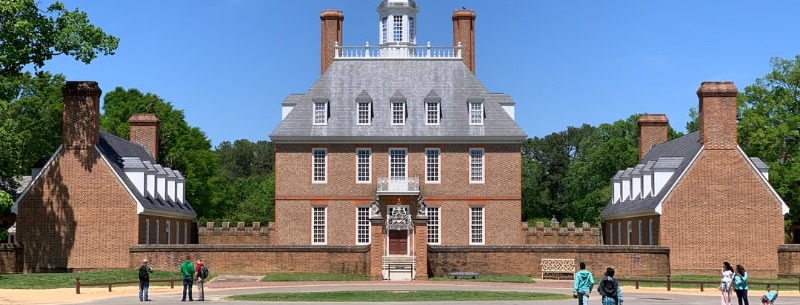Experience life as it was in 18th century Colonial Williamsburg by touring the USA’s largest living history museum. Visitors can stroll through town along the same paths once walked by George Washington, Thomas Jefferson, Patrick Henry, James Madison and others that played leading roles in America’s independence.
Visitors to Colonial Williamsburg can walk along with Duke of Gloucester Street to historic trade shops and see life as it was 200 years ago. The blacksmith, shoemaker, gunsmith, printer, cabinetmaker, and wigmaker work and dress as they did in colonial times.
Firmly rooted in America’s history, Colonial Williamsburg has been recreated for today’s visitors of all ages. Kids especially get to see something they’ll never find in a video game or a classroom. Without even realizing it, your children will be transported to another time and place where the world was more hands-on, where new ideas meant changing the world.
Colonial Williamsburg has plenty to see and it covers a lot of ground, 300+ acres. Wear comfortable walking shoes. Other than the carriage rides, the main transportation will be on foot.
I remember visiting Colonial Williamsburg as a young kid with my parents. Then I just thought it was an old fashioned town and didn’t realize the historic importance of that land or the incredible amount of work that went into recreating the streets of Colonial Williamsburg.
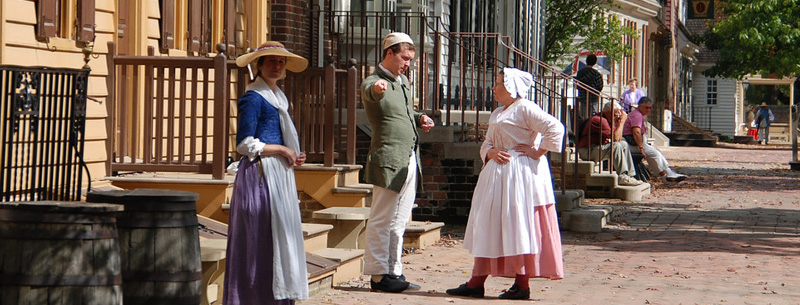
At a young age, I was exposed to our country’s dramatic history but didn’t realize at the time the true significance of that exposure. Years, many years later, I came to appreciate the birth pangs that our country experienced before becoming the bastion of freedom. Colonial Williamsburg has successfully recreated many elements of that struggle for freedom. Not everyone was in favor of severing ties with the Crown. Not everyone wanted to end slavery. It was a cauldron of conflict during mid 18th Century Colonial life. .
George and Martha Washington, Thomas Jefferson, Patrick Henry, just some of the names that barely seem to animate our country’s history books today, come alive here. These streets, the shops, the buildings, the homes, the church are where these historic figures walked, talked and lived. The same streets, buildings where you can stop and spend a few moments appreciating a most historic time in our nation: the days just before and after we became us.
Historic Triangle
- Williamsburg is part of what is called the Historic Triangle. The other 2 corners are the 2 Jamestown centers and Yorktown.
- Jamestown is both a historic park and a recreated historic attraction, each requiring separate admission.
- Yorktown is 3 parts: the Historic Battlefield, the Yorktown Victory Center, and the actual living Village of Yorktown. The village is a small town along the river that has shopping, food, and a beach.
Read more about the Historic Triangle
Colonial Children’s Orientation Walk
The Children’s Orientation Walk is designed to assist guests with planning their visit and will highlight options that families will enjoy. Guides share the latest information on programming, dining, and shopping options. Guests will receive an overview of the 18th-century community and specifically understand what childhood and family life were like in the 18th century. The walking tour lasts approximately 30 minutes. Included in all Historic Area admission passes.
Must-See Attractions
With over 300 acres filled with beautiful gardens, historic buildings and re-enactors seemingly popping up all over the place, what makes sense for the first time visitor to Colonial Williamsburg? Here are a few tips that will help get your feet wet without wearing yourself out.
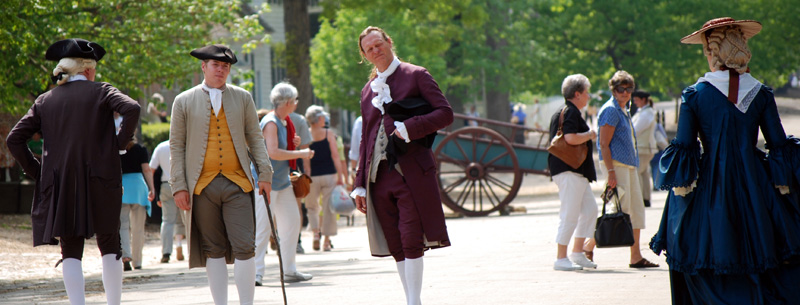
First, start at the Visitor’s Center. This is where you can get a feel for what is going on, purchase tickets, see a film. Don’t eat there or buy drinks there– way too expensive. Use the bus system to get around. Now, here are the main places to see:
Visitor’s Center
Every visit to Colonial Williamsburg should start at the Visitors Center for several reasons. This is one of the few places close to Colonial Williamsburg where you can park for free. Parking anywhere close to the historic areas is not permitted unless you’re a guest at one of the hotels. The Visitors Center is also where you can view an introductory film about the village. The Visitors Center is where tickets are sold as well.
Governor’s Palace
The governor’s residence was home to 7 royal governs and the first 2 elected governors of the Commonwealth of Virginia. The Palace is exquisitely furnished as the home of Lord Dunmore, the last British governor before the Revolutionary War. The Governor’s Palace is located at the north end of the Palace Green which is next to the distinctive Bruton Parish Church.
Capitol
The Capitol was the heart of Virginia politics. It was here in 1776 that Virginia voted for independence. The Capitol building is located at the far end of Duke of Gloucester Street (some call this DOG Street since Duke of Gloucester Street is quite a mouthful) Much of the re-enactors perform historic scenes just west of the Capitol on DOG Street in an area known as Revolutionary City.
Courthouse
Built in 1771, the overhanging portico was originally to have 4 columns, but for some reason, they weren’t installed until fire damage required extensive reconstruction to the building at which time the 4 columns were added. However, when re-construction began on restoring Colonial Williamsburg to its 1770s character, the columns were removed. The Courthouse was home to the Williamsburg City Council for 150 years.
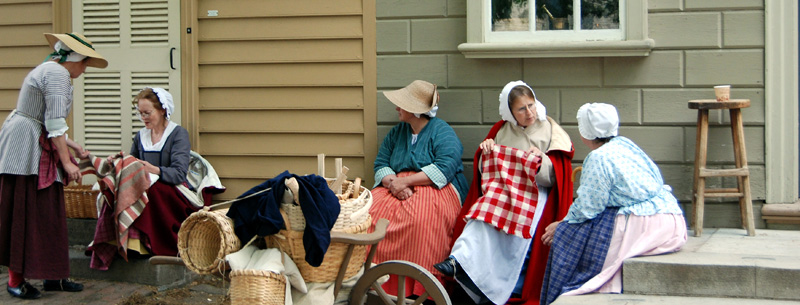
Revolutionary City Vignettes
The area on Duke of Gloucester Street, east of Botetourt Street down to the Capitol Building is where the highly acclaimed outdoor street theater is performed on a daily basis. The presentation is known as Revolutionary City because of the location and the authenticate looking plays are acted out. Meet the men and women, rich and poor, great and humble, free and enslaved, who lived through these extraordinary times that created one nation out of 13 colonies.
This part of Virginia is the cradle of our country. True, we all came together from New England to South Carolina, all contributed, but the vast majority of revolutionary ideas came together here. That concept is recreated daily (weather permitting) with times varying depending on the day and time of year. The entire street is transformed into a street theater with 18th Century Williamsburg characters playing the main roles in vignettes happening in multiple locations. The best way to determine what happens when and where is to consult the free “This Week” guide where events, days of the weeks and times are printed.
Magazine / Artificer’s Shop
The Magazine, located across the road from the Courthouse, is Williamsburg’s arsenal were firearms, powder and flints were stored and dispensed when required. The octagonal-shaped Magazine was built in 1715 and was used by Lt. Col. George Washington during the French and Indian War. Because of so many weapons and over 60,000 pounds of gunpowder stored inside, an extra security wall was added. The extra security did not stop the British from seizing all of the gunpowder as hostilities erupted between the colonists and the British in 1775.
On the backside of the main entrance is the Artificer’s Shop. Here all of the leather supplies and repairs required for the military regiments are made.
Blacksmith
Most people think the Blacksmith was were you went to get your horses shod, but in the colonial period, the blacksmith is the guy that made just every piece of hardware was used in day-to-day living and also repaired these items when they broke. He also repaired muskets, swords, bayonets. Unlike today, the colonial period was not a throwaway civilization. If it broke, it got fixed. Only when it wore out and wasn’t able to be fixed another time, did they replace the item? Blacksmith Shop is located on George Street, just west of the Palace Green.
Peyton Randolph House
Peyton Randolph was one of Virginia’s most influential politicians and like most politicians, there were plenty of people looking to find favor. Peyton hosted many important social and political gatherings at his home. Before Geo. Washington was bestowed with the honorary title “father of the country” it was unequivocally given to Peyton Randolph. Randolph House is located at the corner of Nicholson Street and N. England Street, 1 block east of the Palace Green.
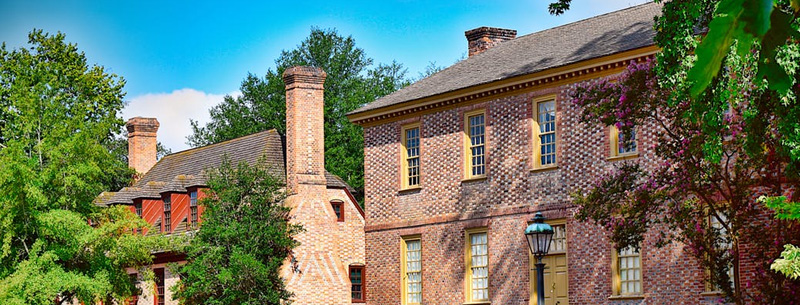
Printing Office
The local printer was like the internet is today: it’s where people went to get their message spread throughout the community and the colonies as quickly as possible. From this location, Virginia’s first newspaper published that included odd bits of domestic news as well as foreign news. It also provided a means for local merchants to advertise their wares and services, for a fee!
Area Attractions and Amenities
When you’re in the village you forget that Colonial Williamsburg is a big tourist attraction. The flashing neon signs, the glitter, the plastic are all there, just not inside the village. There are plenty of places open to provide goods, food, and merchandise. There’s also a variety of lodging options with the caveat that the closer you are to the village, the more expensive those lodgings are likely to be. Where you stay depends on your plans. If you’re spending just a day or two, then you might want to spend those valuable hours inside the historic area instead of traveling to and from the village. If you’re going to be spending time visiting the other nearby areas, then perhaps lodging outside the village would better suit your needs.
Historic District Shopping
Who doesn’t like to do a little shopping when they go on vacation? Colonial Williamsburg has plenty of opportunities. Inside the historic village, there are all kinds and types of shops offering a variety of merchandise and wares fitting the period. Outside of the village, there are also a great number of shops offering an even great selection of merchandise.
Inside the village, you can shop where George Washington and Thomas Jefferson shopped. It is said that Washington purchased earrings for Martha at the Golden Ball during one of his visits here. Jefferson, a life-long book lover, purchased printed materials at the printing office.
There are some 10 shops in the historic area where items similar to what would have been found here during colonial times, can still be purchased. There are also several seasonal outdoor sites.
Christmas at Williamsburg
Each year between Thanksgiving and the New Year, visitors flock to the streets of Williamsburg to see the holiday decorations. Forget the electric lights, the glitter of plastic, all the decorations are natural and handmade. Here is my sampling of decorations set to music.
